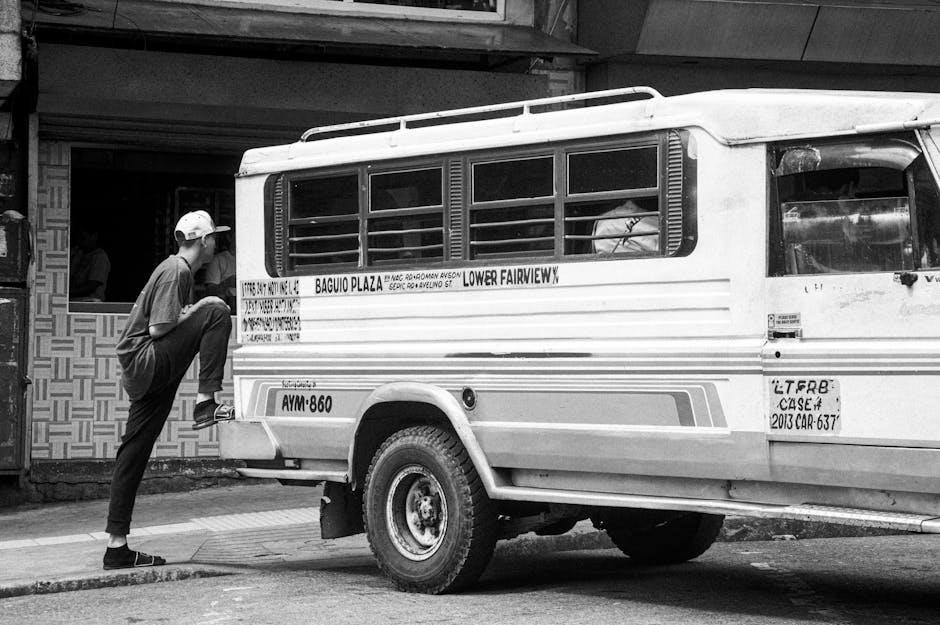The 2004 Jeep Grand Cherokee Manual is a comprehensive guide essential for owners, covering operation, maintenance, troubleshooting, and repair. Written by specialists, it provides detailed instructions for DIYers and professionals.
1.1 Overview of the Manual
The 2004 Jeep Grand Cherokee Manual is a detailed guide covering vehicle operation, maintenance, and repair. It includes sections on technical specifications, troubleshooting, and step-by-step repair procedures. Designed for both DIY enthusiasts and professionals, the manual offers comprehensive instructions for understanding and servicing the vehicle. Available in PDF and print formats, it provides essential information for optimizing performance and ensuring longevity. The manual is organized into clear chapters, making it user-friendly for owners seeking to maintain or repair their Grand Cherokee effectively.
1.2 Importance of the Manual for Vehicle Maintenance
The 2004 Jeep Grand Cherokee Manual is crucial for proper vehicle maintenance, ensuring optimal performance and longevity. It provides detailed instructions for routine checks, oil changes, and fluid replacements, helping owners prevent costly repairs. The manual also includes troubleshooting guides for common issues, such as engine problems or transmission faults, enabling timely resolutions. By following the manual’s recommendations, owners can maintain their Grand Cherokee’s health, enhance safety, and preserve its value over time. Regular maintenance, as outlined, is key to extending the vehicle’s lifespan and reliability.

Technical Specifications of the 2004 Jeep Grand Cherokee
The 2004 Jeep Grand Cherokee features robust engine options, advanced drivetrain systems, and durable suspension designs. Its specifications ensure superior off-road capability and reliable performance.
2.1 Engine Options and Performance
The 2004 Jeep Grand Cherokee offers a range of powerful engines, including a 4.0L inline-6, 4.7L V8, and a 2.7L diesel option. These engines deliver robust horsepower and torque, ensuring strong off-road and towing capabilities. The inline-6 provides reliable performance with decent fuel efficiency, while the V8 emphasizes power for heavy-duty tasks. The diesel variant excels in torque, ideal for hauling and long-distance driving. Each engine is paired with advanced systems to optimize performance and durability, making the Grand Cherokee a versatile choice for various driving conditions.
2.2 Transmission and Drivetrain
The 2004 Jeep Grand Cherokee features a range of transmissions, including a 4-speed automatic and a 6-speed manual, designed to pair with its engine options. The drivetrain includes rear-wheel drive (RWD) and four-wheel drive (4WD) systems, offering enhanced traction and control. The Quadra-Trac II 4WD system provides seamless torque distribution, while the optional Quadra-Drive II adds electronic limited-slip differentials for superior off-road capability. These systems ensure optimal performance in various driving conditions, from paved roads to rugged terrain, making the Grand Cherokee a highly versatile SUV.
2.3 Suspension and Steering Systems
The 2004 Jeep Grand Cherokee features a coil-link front suspension and a multi-link rear suspension, designed for both on-road comfort and off-road durability. The suspension incorporates high-strength steel components to reduce weight while maintaining rigidity. The power-assisted recirculating ball steering system provides precise control and enhanced maneuverability, particularly at low speeds. This setup ensures stability and responsiveness, making it suitable for diverse driving conditions. The steering gear is mounted above the front axle, offering improved durability and protection against off-road hazards.
2.4 Dimensions and Capacities
The 2004 Jeep Grand Cherokee features a wheelbase of 105;9 inches, with an overall length of 186.6 inches, width of 72.3 inches, and height of 66.7 inches. Its ground clearance stands at 8.3 inches, providing ample off-road capability. The vehicle has a curb weight of approximately 4,240 pounds, with a maximum towing capacity of 7,200 pounds for the 4.0L engine and up to 7,950 pounds for the 5.7L V8. The fuel tank capacity is 23 gallons, and the payload capacity is around 1,150 pounds, making it versatile for both on-road and off-road use.

Maintenance and Servicing Guidelines
Regular maintenance is crucial for the 2004 Jeep Grand Cherokee’s longevity. Follow the manual’s guidelines for routine servicing, inspections, and part replacements to ensure optimal performance and reliability.
3.1 Routine Maintenance Schedule
The 2004 Jeep Grand Cherokee manual outlines a detailed routine maintenance schedule. It specifies intervals for oil changes, tire rotations, and inspections of belts, hoses, and fluid levels. Adhering to this schedule ensures optimal vehicle performance and prevents potential issues. Regular checks of air filters, spark plugs, and brakes are also recommended. By following the manual’s guidelines, owners can maintain their vehicle’s health and extend its lifespan. Proper scheduling helps in identifying and addressing problems early, reducing repair costs and enhancing safety.
3.2 Oil Change and Fluid Replacement
The 2004 Jeep Grand Cherokee manual emphasizes the importance of regular oil changes and fluid replacements. It recommends using 5W-30 oil for optimal performance. The manual specifies oil capacity for 4.0L and 4.7L engines, ensuring proper lubrication. Fluid replacements, such as coolant and transmission fluid, are also detailed. The guide provides step-by-step instructions for draining and refilling fluids, ensuring safety and efficiency. Proper disposal of used fluids is advised to protect the environment. Following these guidelines helps maintain engine health and prevents premature wear.
3.3 Tire Pressure and Wheel Alignment
The 2004 Jeep Grand Cherokee manual stresses the importance of proper tire pressure for optimal performance and safety. It recommends checking pressure when tires are cold and adjusting according to the specifications in the manual. Regular tire pressure checks ensure even tread wear and improve fuel efficiency. The manual also provides guidelines for wheel alignment, emphasizing its impact on handling and tire longevity. Proper alignment prevents uneven wear and enhances overall vehicle stability. Adhering to these recommendations ensures a smooth and safe driving experience. Use a tire pressure gauge and consult the manual for precise specifications.
3.4 Brake System Inspection and Service
Regular inspection of the brake system is crucial for safety; The manual recommends checking brake pads, rotors, and fluid levels every 10,000 to 15,000 miles. Inspect for wear, damage, or leaks. Replace worn pads and resurface rotors as needed. Brake fluid should be free of contamination and at the recommended level. Hoses and lines must be checked for cracks or damage. Proper maintenance ensures reliable braking performance and prevents costly repairs. Always follow the manual’s guidelines for servicing to maintain optimal safety and vehicle functionality.

Troubleshooting Common Issues

The manual helps identify symptoms like unusual noises, warning lights, or reduced performance. It guides through diagnostic steps, such as checking fluid levels and error codes, to resolve issues effectively.
4.1 Identifying Common Problems
The manual outlines common issues like engine stalling, transmission slipping, or brake failures. It provides symptom-based diagnostics, helping owners pinpoint problems such as fluid leaks, unusual noises, or warning lights. Detailed descriptions guide users through troubleshooting steps for systems like the engine, transmission, and suspension. By referencing the manual, drivers can identify issues early, preventing costly repairs. Tips for using diagnostic tools and error codes are included, ensuring effective problem-solving and maintenance.
4.2 Diagnostic Steps for Engine Issues
The manual provides detailed diagnostic steps for engine-related problems. Start by scanning for error codes using a diagnostic tool. Check oil, coolant, and fuel levels. Inspect air filters, spark plugs, and belts for wear. Verify proper fuel pressure and ignition system function. Monitor engine temperature and exhaust emissions. Refer to the manual for specific troubleshooting charts and repair procedures. Regular inspections can help prevent major engine damage, ensuring optimal performance and longevity of your 2004 Jeep Grand Cherokee.
4.3 Transmission and Drivetrain Troubleshooting
The manual details steps to diagnose transmission and drivetrain issues in the 2004 Jeep Grand Cherokee. Common problems include slipping gears, unusual noises, or loss of 4WD engagement. Start by checking transmission fluid levels and condition. Inspect for leaks, worn seals, or damaged components. Use diagnostic tools to scan for error codes related to the transmission or transfer case. Refer to the manual’s troubleshooting charts for specific symptoms and repair guidance. Proper maintenance and timely repairs are crucial to ensure smooth operation and longevity of the drivetrain system.
4.4 Electrical System Faults and Solutions
The 2004 Jeep Grand Cherokee Manual addresses common electrical system issues, such as faulty wiring, dead batteries, or malfunctioning sensors. Start by checking battery connections for corrosion and ensuring proper charging. Use a multimeter to test circuits and fuses, referencing the manual’s wiring diagrams for accuracy. Addressing issues like flickering dash lights or intermittent power loss requires systematic troubleshooting. Cleaning corroded terminals and replacing blown fuses are common solutions. Always consult the manual before attempting repairs to avoid further damage or electrical system instability.

Repair and Replacement Guidance
This section offers detailed guidance for repairs and replacements, providing step-by-step instructions for both DIY enthusiasts and professional mechanics to ensure proper vehicle maintenance.
5.1 Replacing Parts: A Step-by-Step Guide
Replacing parts in your 2004 Jeep Grand Cherokee requires careful planning and execution. Always start by identifying the correct part using the manual or manufacturer’s specifications. Purchase genuine or compatible components to ensure proper fitment. Prepare your workspace with necessary tools and safety gear. Follow the manual’s disassembly instructions to access the faulty part. Install the new component in reverse order, ensuring all connections are secure. Test the vehicle to confirm functionality. Dispose of old parts responsibly. Refer to diagrams for visual guidance to avoid errors during replacement.
5.2 Tools and Equipment Required for Repairs
Proper tools and equipment are essential for effective repairs on your 2004 Jeep Grand Cherokee. Essential tools include wrenches, screwdrivers, pliers, and a socket set. Specialized tools like a torque wrench and multimeter may be needed for specific tasks. The manual often lists required tools for each procedure. Additionally, a jack, jack stands, and wheel chocks are crucial for safe lifting and stabilizing the vehicle. Protective gear like gloves and safety glasses should always be used. Refer to the manual for detailed tool specifications and torque values to ensure accurate repairs.
5.3 Welding and Fabrication Tips
Welding and fabrication are critical for repairs and modifications on the 2004 Jeep Grand Cherokee. Use a MIG welder for steel components, ensuring proper shielding and clean surfaces. Select appropriate materials, like high-strength steel, to maintain durability. Safety gear, including a welding helmet and gloves, is essential. For complex fabrication, such as frame repairs, consult a professional. Always follow proper techniques to avoid warping or weakening the structure. Refer to the manual for specific guidelines and torque specifications to ensure reliable results. Proper welding practices are vital for maintaining vehicle integrity and safety.

Safety Precautions and Best Practices
Always wear protective gear and ensure the vehicle is on level ground. Disconnect the battery before starting work to prevent electrical shocks or accidental starts. Use jack stands for added safety and refer to the manual for specific guidelines to avoid injuries and ensure proper repairs.
6.1 Safety Measures While Working on the Vehicle
Always prioritize safety when working on your 2004 Jeep Grand Cherokee. Disconnect the battery before starting repairs to prevent electrical shocks. Use jack stands for lifting the vehicle, ensuring stability and preventing accidents. Wear protective gear, including gloves and safety glasses, to shield yourself from potential hazards. Ensure proper ventilation when working with chemicals or in enclosed spaces. Follow the manual’s guidelines for specific procedures and never bypass safety protocols. Turn off all electrical components before starting work, and always chock the wheels when the vehicle is raised.
6.2 Proper Use of Jacks and Stands
Always use the correct jacks and stands when lifting the 2004 Jeep Grand Cherokee. Follow the manual’s guidelines for jack placement to avoid damage or instability. Engage the parking brake and place blocks behind the wheels for added safety. Never rely solely on a jack; always use jack stands for support. Position the jack under the vehicle’s designated lift points to ensure even weight distribution. Lower the vehicle slowly and carefully to maintain control. This ensures a safe working environment and prevents potential accidents during repairs or maintenance.
6.3 Handling Hazardous Materials Safely
When working with the 2004 Jeep Grand Cherokee, handle hazardous materials like motor oil, coolant, and battery acid with care. Always wear protective gloves and goggles to prevent skin and eye irritation. Ensure proper ventilation when dealing with volatile substances. Store these materials in sealed containers and keep them away from heat sources or open flames. Dispose of hazardous waste responsibly, following local regulations to prevent environmental contamination. Refer to the manual for specific guidelines on handling and disposing of these materials safely.

History of the 2004 Jeep Grand Cherokee Model
The 2004 Jeep Grand Cherokee, part of the WJ generation, was released in 2003, featuring enhanced design, technology, and performance, including the 5.7L HEMI engine.
7.1 Release and Features of the 2004 Model
The 2004 Jeep Grand Cherokee, part of the WJ generation, was introduced with a focus on enhanced performance and technology. It featured a redesigned interior, improved suspension systems, and advanced engine options, including the 5.7L HEMI V8 for increased power. The model also incorporated new safety features and a refined 4×4 system, such as the Quadra-Drive II, offering superior off-road capability. This iteration was well-received for its balance of ruggedness and comfort, making it a standout in its class during its release year.
7.2 Design and Technology Upgrades
The 2004 Jeep Grand Cherokee featured a sleek, updated design with improved aerodynamics and a refined interior. It introduced advanced technology, including a modern infotainment system and optional navigation. The Quadra-Drive II 4×4 system offered enhanced off-road performance, while the available 5.7L HEMI V8 engine delivered increased power and efficiency. Suspension improvements provided a smoother ride, and safety upgrades like Electronic Stability Control and side airbags were added. These upgrades made the 2004 model a leader in both capability and comfort.
7.3 Reception and Impact in the Market
The 2004 Jeep Grand Cherokee received positive reviews for its performance, design, and technology upgrades. It was praised for its off-road capabilities and refined on-road manners. The model won several awards, including Motor Trend’s SUV of the Year, highlighting its strong market presence. Its popularity led to solid sales, making it a key player in the SUV segment. Customers appreciated its durability and versatility, while critics noted its improved safety features and powerful engine options. The 2004 Grand Cherokee’s success further solidified Jeep’s reputation as a leader in the automotive industry.

Downloading and Accessing the Manual
The 2004 Jeep Grand Cherokee manual can be downloaded from official Jeep websites or third-party forums. It’s available as a free PDF, offering detailed instructions and specifications for easy access.
8.1 Sources for the 2004 Jeep Grand Cherokee Manual
The 2004 Jeep Grand Cherokee manual can be sourced from the official Jeep website, authorized dealerships, or trusted third-party forums like Jeep enthusiast communities. Additionally, online marketplaces such as eBay offer both digital and physical copies. Some repair shops and libraries also provide access to these manuals. Ensure to verify the authenticity and completeness of the manual before downloading or purchasing to guarantee accurate and reliable information for maintenance and repairs.
8.2 Tips for Navigating the Manual
Start by reviewing the table of contents to locate specific sections quickly. Use the index for keyword searches to find detailed information efficiently. Pay attention to diagrams and illustrations, as they provide visual guidance for complex procedures. Familiarize yourself with symbols and abbreviations used throughout the manual. For troubleshooting, refer to the diagnostic sections first. Always Cross-reference parts and tools required before starting any repair. Regularly bookmark or highlight important pages for easy access. This organized approach ensures you maximize the manual’s utility for maintenance and repairs.

Additional Resources and References
The 2004 Jeep Grand Cherokee Manual is supported by additional resources, including service manuals, transmission guides, and parts catalogs. Online forums and communities offer further troubleshooting and maintenance tips.
9.1 Recommended Tools and Equipment
The 2004 Jeep Grand Cherokee Manual recommends specific tools for repairs, such as torque wrenches, multimeters, and jack stands. Specialized tools like transmission service kits and diagnostic equipment are also essential. These tools ensure proper maintenance and repairs, aligning with the manual’s guidelines. They are available at Jeep dealerships or auto repair shops, helping owners maintain their vehicle effectively and safely. Investing in these tools is crucial for DIY enthusiasts and professionals alike to handle various tasks efficiently.
9.2 Online Forums and Communities
Online forums and communities are invaluable resources for 2004 Jeep Grand Cherokee owners. Platforms like Jeep enthusiast forums and specialized automotive groups offer extensive discussions, downloadable manuals, and technical advice. Members share experiences, troubleshooting tips, and repair guidance, fostering a supportive environment for DIY projects. These communities often include contributions from experienced mechanics and long-time owners, making them a trusted source for maintaining and upgrading your vehicle effectively. Active participation can enhance your knowledge and problem-solving skills, ensuring optimal performance and longevity for your Jeep.
9.3 Professional Repair Services
For complex repairs, the 2004 Jeep Grand Cherokee manual recommends consulting professional repair services. Authorized dealers and certified technicians ensure adherence to manufacturer standards, using specialized tools. These services cover diagnostics, advanced troubleshooting, and component replacements, guaranteeing reliability and safety. Regular maintenance by professionals prevents issues and extends the vehicle’s lifespan, offering peace of mind for owners who prefer expert care over DIY solutions.
The 2004 Jeep Grand Cherokee manual is a vital resource for owners, offering detailed guidance on maintenance, troubleshooting, and repair. Regular use ensures optimal vehicle performance and longevity.
10;1 Final Thoughts on the Importance of the Manual
The 2004 Jeep Grand Cherokee manual is a vital resource for owners, providing essential insights into maintenance, troubleshooting, and repairs. It empowers users with the knowledge to keep their vehicle in optimal condition, ensuring safety and performance.
By adhering to the manual’s guidelines, owners can prevent costly issues, extend the vehicle’s lifespan, and maintain its value. It is a cornerstone for DIY enthusiasts and professionals alike, fostering a deeper understanding of the Grand Cherokee’s mechanics and care.
10.2 Encouragement for Regular Maintenance
Regular maintenance is crucial for extending the life of your 2004 Jeep Grand Cherokee. By following the manual’s guidelines, you can identify and address potential issues early, preventing costly repairs and ensuring optimal performance.
Consistent upkeep not only enhances safety but also maintains the vehicle’s reliability and efficiency. Encourage yourself to stay proactive with scheduled services, as outlined in the manual, to keep your Grand Cherokee running smoothly for years to come.
